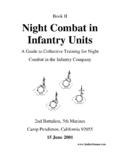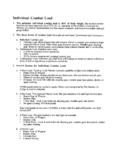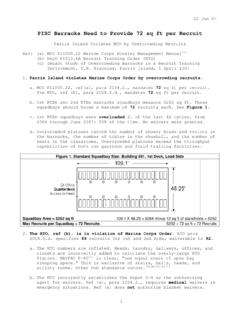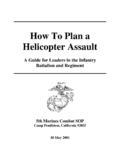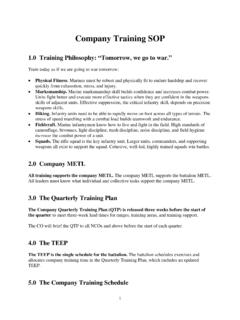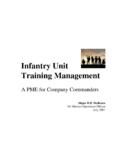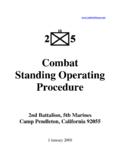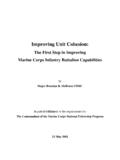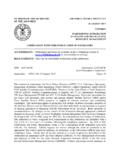Transcription of Warfighting Cliff Notes - 2ndbn5thmar.com
1 Warfighting Cliff Notes A Synopsis of MCDP 1 Warfighting United States Marine Corps Marine Corps Warfighting Lab Marine Corps Combat Development Command Quantico, Virginia 10 May 1998 1 Warfighting Cliff Notes A Synopsis of MCDP 1 Warfighting Foreword. This publication describes the philosophy which distinguishes the Marine Corps. This publication provides the authoritative basis for how we fight and how we prepare to fight. While not a reference, this manual is meant to give broad guidance in the form of concepts and values. This doctrine applies to all Marines. I expect all Marines to read this book, understand it, and act upon it. This publication describes a philosophy for action. The concepts in this book dictate our approach to duty, war, and peace. KRULAK General, Marine Corps Commandant of the Marine Corps Chapter 1: The Nature of War War Defined.
2 War is a violent clash of interests between or among organized groups characterized by the use of military force. These groups are not always nations, but can be political groups, terrorists, or guerrillas within nations. The essence of war is a violent struggle between two hostile, independent, and irreconcilable wills, each trying to impose itself on the other. The object in war is to impose our will on the enemy. We do this by threatening or using military force. War may range from battles between large military forces to smaller guerrilla clashes. Military force can be used to restore civil peace, or overturn the existing social order. Friction. Countless factors make war difficult to conduct. When the simple is difficult, and the difficult is impossible, we have friction. Friction can be mental or physical. It can come from enemy actions, terrain and whether, or be self-imposed. War is a human endeavor. Friction has a psychological effect.
3 The main weapon against friction is the human will. Training and experience will teach us how to fight in an environment of friction. Uncertainty. Uncertainty is the fog of war. All decisions in war will be based on incomplete, inaccurate, or contradictory information. We cannot predict the enemy s actions. Through training, we learn what our capabilities are. We must make sound decisions despite uncertainty. It is important to realize that even small actions in war can have great effects. Every decision counts. War involves risk. Greater gains often involve greater risk. That does not mean that we should conduct ourselves with reckless abandon. 2 Chance plays a role in war. Neither we nor the enemy may be able to control events. We must be flexible enough to take advantage of the opportunities which chance gives us. Fluidity. No one event in war can be isolated. It has been shaped by all of the previous events. Thus war providing fleeting opportunities and surprises.
4 Flexibility is required to adapt to a constantly changing situation. We must also be proactive and shape events to our advantage. War ebbs and flows like the tides. A high operational tempo cannot be supported forever. Formations will mass to attack the enemy, then disperse. Disorder. In the fog of war, disorder rules the battlefield. Plans are overcome by events. Flexibility and opportunistic will is required. Complex plans rarely work after the first shots. Complexity. War is not a conflict between two individuals, but between forces consisting of many individuals. War emerges from the collective behavior of the individual parts and players responding to local conditions. No one commander can control every aspect of war. The Human Dimension. The human will is the central factor in war. War is shaped by human morals and emotions. It is an extreme test of physical strength, will, and stamina. Through proper leadership, the human will drives all actions in war.
5 Violence and Danger. Violence is an element of war. It produces the greatest horrors. Danger is ever present, along with fear. Fear weakens the will. Leaders study fear and learn to counteract it, building unit cohesion and self-confidence. Courage is strength to overcome fear. Physical, Moral, and Mental Forces. The physical forces of war are easily recognized, such as men and material. The moral factors, such as a nation s resolve, are hard to grasp. Mental factors affect our ability to outthink our enemy. Just because the moral and mental factors are hard to identify, does not mean that they can be neglected. The Evolution of War. The nature of war is constant. Its methods are ever changing. A major cause of these changes is technology. We must be on the cutting edge of tactics and technology while not forgetting those fundamentals which is time tested and constant. The Science, Art, and Dynamic of War. The science of war applies to those elements which can be measured by scientific methods.
6 This includes ballistics or the effects of weapons. The art of war requires an intuitive ability to assess a situation and decide upon a course of action. Tactics must fit a particular situation with the assets on hand. War is characterized by human competition. War is a social interaction affected by boldness, spirit, and will. Conclusion. War is a complex endeavor. It is shaped by the human will. It is characterized by friction, uncertainty, fluidity, danger and disorder. While the nature of war is constant, it remains unpredictable, and is affected by a mix of physical, moral and mental factors. While war has the characteristics of both art and science, it is primarily shaped by human experience. 3 Chapter 2: The Theory of War War As an Act of Policy. War is an extension of both policy and politics with the addition of military force. Policy refers to the conscious objectives established in the political process. War must serve policy.
7 We must not establish goals outside of our capabilities. Many political problems cannot be solved by military means. As war tends to take its own course, the decision to enter into war must be carefully weighed. War is not simply an extension of policy or politics. War involves cultural, psychological and social factors. These factors affect the course of war as well as war s usefulness for solving particular problems. The nature of war becomes more destructive as the policy goal of a war becomes more extreme. The destruction of a government yields more violence than a more limited policy objective. Political considerations may restrict the use of military force. A strategy of annihilation seeks to destroy an enemy s military power. We do not have to physically destroy an enemy s forces, but can incapacitate them. We can reach policy goals by paralyzing the enemy. A strategy of erosion seeks to erode the enemy s will. We raise the price of resisting our will.
8 We use this force to meet goals we believe the enemy will eventually give in to. Means in War. At the highest level, war involves economic, diplomatic, and psychological forces as well as military force. The Spectrum of Conflict. War ranges from total war to military operations other than war (MOOTW). MOOTW includes peacemaking operations and humanitarian relief. Small wars are more probable than a general war . The Marine Corps must be prepared to respond to any situation. Low intensity conflicts often have very high intensity firefights. Levels of War. Actions in war take place on several related levels. The strategic level involves national strategy and military strategy. National strategy sets policy objectives and mobilizes the nation s resources for attaining these goals. Military strategy focus on the military means for attaining policy goals. At the strategic level, forces are distributed and theaters of war are established.
9 The lowest level is the tactical level. Tactics refers to the techniques and methods for accomplishing a particular mission. Tactics focus on defeating the enemy at a particular place and time. Tactics are focused on winning battles. The operational level of war links tactics and strategy. At the operational level, we decide where, when and under what conditions we will meet the enemy. The operational level is focused on winning campaigns. 4 The levels of war overlap and affect each other from the top down and from the bottom up. Initiative and Response. All actions in war are based on either the initiative to act or a response to an action. Through initiative we seek to impose our will and bring the enemy to our terms. While the striking power of the offense is usually associated with initiative, a good defense also seizes the initiative. The defense can contain a clever way to paralyze the enemy. We cannot maintain the offense indefinitely.
10 When our ability to continue to attack is gone, we must switch to the defense. This is the culminating point. The offense is most vulnerable to counterattack at this point. The offense and defense are not completely separate attitudes. Each contains the other. The defense uses patrols and spoiling attacks. The offense requires economy of force actions. Initiative and response vary at different levels. A nation may be reacting at the strategic level while at a particular place its forces are imposing their will on the enemy. Styles of Warfare. The styles of warfare exist on a spectrum between attrition and maneuver. Attrition seeks to wear down an enemy s material resources. Maneuver warfare seeks to circumvent problems and attack them from a position of advantage. Maneuver warfare seeks to paralyze the enemy system. In maneuver warfare, enemy strengths are avoided and weaknesses are exploited. Maneuver warfare requires speed and surprise, and involves greater risk.

